Generally, a rotating machine has two parts in common one is a stationary part and another is a rotating part. The stationary part of the DC (Direct Current) machine contains several components of the machine such as field winding, pole shoes, bearings, etc. Whereas the rotating part of the DC machine has armature winding, armature core, shaft, commutator, brushes, etc for the construction of DC machine. Here I am discussing them one by one.
Table of Contents
A rotating part of the DC machine is known as the rotor. Whereas the stationary part is known as the stator. A rotor and a stator have the least possible air gap (1-2mm), to avoid magnetic flux leakage.
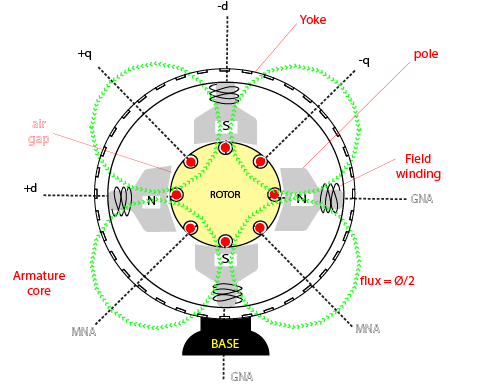
DC machine Construction
The shaft of a DC machine
The shaft of a dc machine uses iron/steel depending upon the applications. But for heavy usage, it uses mild steel. The shaft also comes with grooves on it. The position of the grooves also depends upon the position of the armature core and bearings, commutator, etc.
| Shaft contains | Armature winding, Brushes, Commutator |
| Shaft separates | rotating and stationary parts |
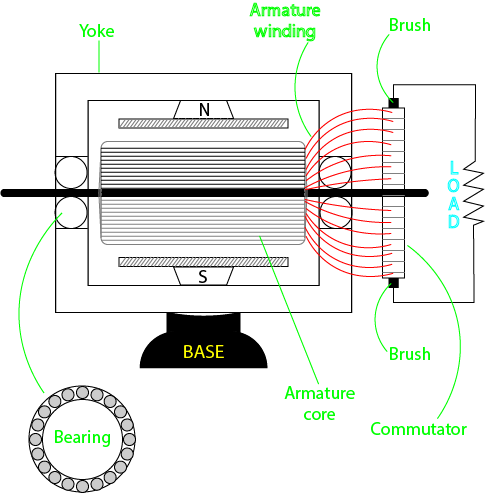
A shaft of a DC machine is a part of the mechanical equipment which separates the rotating part and the stationary part. A shaft has all the rotating pieces of equipment on it. Like armature winding, bearings, armature slots, commutator, etc.
A design engineer decides the thickness and material of the shaft. So that it can handle torque and speeds required, without wear and tear. A bearing is attached to the ends of the shaft to rotate on the stator.
Nowadays shaft is made up of mild steel. This is much brittle to handle the heavy loads. Primarily shaft was made of iron. But after further studies, it came to the result that it should be replaced with steel. This eliminates rusting in the machine. And needs less repair.
The yoke of a DC machine
Yoke holds all the parts intact. Details of a Yoke of a DC machine are:
- Yoke has good permeability.
- Yoke gives support to the poles.
- It completes the magnetic Flux path in a machine (ϕ/2). And ϕ=flux per pole.
Old design:
- Small Machine-made of Cast iron.
- Large Machine-made of Cast iron/Fabricated steel.
Recent design:
- Small Machine – Fabricated steel.
- Special applications (power electronics converters) – Laminated steel.
In short, advanced studies take care of the fabrication to meet the best results. Nowadays the machine has the best available yoke.
Bearings in a DC Machine
Bearings in a machine separate stationary and rotating parts. There are several types of bearings in the DC machine for example BALL BEARING, ROLLER BEARING, and SLEEVE BEARING. These all have different qualities with different types of applications.
| Ball bearings OR double ball bearing | small and medium-range machine |
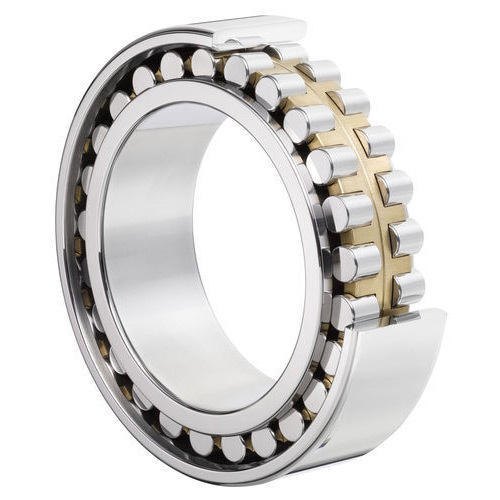
| Roller bearing | Large /heavy duty machine. |
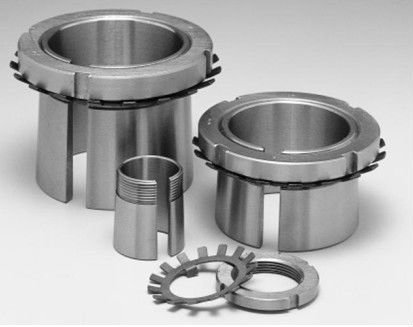
Sleeve bearing – Toys / very small machine.
Commutator of a DC Machine
A commutator acts as a rotating electrical switch to the DC electrical machine. Which helps to convert AC output to DC output in a DC generator and vice-versa. Each coil has two sides and each commutator segment carries two coil sides (Due to the series connection of the winding). In generators, these commutators collect current using brushes.
Therefore, the number of commutator segments = the number of coils.
- The commutator is made up of hard-drawn copper.
- The commutator is the image of winding.
- Brushes are always stationary.
- As a result, Out of two brushes (in a pair), one brush is collecting the current and the other is delivering the current.
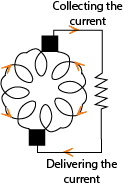
Brushes in a DC Machine
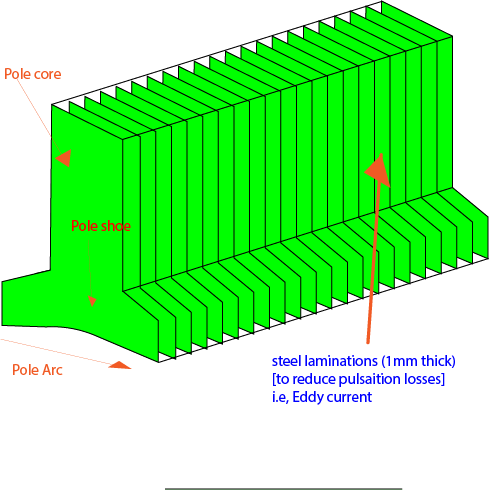
Brushes in a DC Machine are made up of copper, carbon, Electro Graphite, Cu-Graphite, or Ca-Graphite. A brush is used to collect current from the rotating commutator and winding. These are placed in brush holders with the springs for good mechanical conditions. If they collect current without any sparks then commutation is successful. DC Machine designing will be for successful communication.
Sparks are the currents in air gaps. Sparks are produced due to varying mechanical tensions.
Since brushes are stationary but commutator segments. As commutators are the image of Armature windings, sparks get into windings also which causes a dead short circuit.
When Brushes in a DC Machine come on the split, the coil gets a short circuit. Therefore brushes should short circuit the coil along MNA (because induced EMF is zero at MNA, so no short circuit current produces.
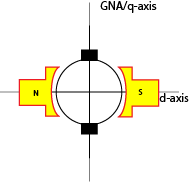
| physically | physically |
| split along- >> q-aixs | split along- >> d-aixs |
| coil along ->> d-axis | coil along ->> q-axis |
| brush along->> q-axis | brush along->> d-axis |
| Hence, coil gets short circuited along d-axis (Wrong method) reason mentioned above. | Hence, coil gets short circuited along q-axis (correct method) |
In order to have successful communication, the Brushes in a DC Machine are physically placed along the d-axis to short circuit the coil along the q-axis. But schematically brushes are shown at q-axis OR MNA.
[If we have not asked physically/schematically. Generally, brushes are placed along MNA.]
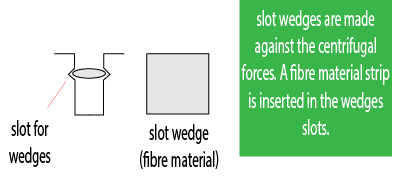
“Coil voltages are limited to a maximum of 30V due to insulation requirements.”
Poles of a DC machine
The poles in a machine are used to produce working flux or field flux. They may be either permanent magnets or Electromagnets.
The poles of a DC machine are riveted into the stator using a screw.
A pole shoe is the bottom of the pole which is greater in size than the rest of the pole. A Pole shoe has a curved surface rather than the flat surface to make a larger area and avoid flux leakage. The air gap between the pole shoe and the armature is very less so that leakage doesn’t occur.
There are some equivalent quantities in the electrical and magnetic circuits. These quantities are related to the quantities used in magnetic and electric circuits.
Electrical quantities Equivalent to magnetic quantities:
| Electrical quantity | Magnetic quantity |
|---|---|
| current (I) | flux (ϕ) |
| EMF or Voltage | MMF=N*I N=number of turns |
| Resistance (R) | Reluctance (S) |
| I=V/R | ϕ = N*I/S |
Construction of Poles of a DC machine
- Excitation of the pole winding (field winding) is always a DC voltage. Because, if AC voltage is used for excitation then the electromagnet will alternate its polarity 500 times in one cycle, so the machine will not work properly.
- The reluctance of the magnetic circuit has to be as low as possible because, In order to produce the same amount of flux in the circuit, more MMF is required (If the reluctance is increased). More MMF means an increase in the size of the machine.
Note: That’s why machines are provided with the least air gap.
\mu_0 (permeability) = 4\pi \times 10^{-7}\in_0 (permittivity) = 8.854 \times 10^{-12}As you can see from the above values, Permeability is more as compared to permittivity.
That’s why, Magnetic medium is preferred over Electric medium, in all kinds of machines.
Problems If using Permanent magnets pole:
- Flux is not controllable.
- Also, flux is not so strong.
Why do the poles (of a DC machine) shoes have extended/flat surfaces?
- The flat surface of the poles shoes will have a larger surface area, Hence Reluctance reduces.
- It uniformly spreads the flux over the wounded armature core.
- This kind of structure avoids saturation.